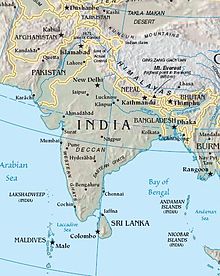| Revision as of 23:30, 25 July 2004 view source24.189.3.230 (talk)No edit summary← Previous edit | Revision as of 04:59, 7 August 2004 view source Moverton (talk | contribs)Extended confirmed users8,660 editsm categoriesNext edit → | ||
| Line 1: | Line 1: | ||
| ] | ] | ||
| '''South Asia''' is a subregion of ] comprising the modern states of ], ], ], ], ], ], and the ]. It covers about 4,480,000 km |
'''South Asia''' is a subregion of ] comprising the modern states of ], ], ], ], ], ], and the ]. It covers about 4,480,000 km², or 10 percent of the continent and is also known as the ]. | ||
| Subregions of South Asia include: | Subregions of South Asia include: | ||
| Line 8: | Line 8: | ||
| *Southern ], ] | *Southern ], ] | ||
| South Asia ranks among the ]'s most crowded places. About 1 1/3 billion people live there—about a third of all ]s and a fifth of all the people in the world. The region's population density of 305 persons per km |
South Asia ranks among the ]'s most crowded places. About 1 1/3 billion people live there—about a third of all ]s and a fifth of all the people in the world. The region's population density of 305 persons per km² is more than seven times the world average. | ||
| The region has a long history. Ancient civilisations developed in the ] Valley. The region was at its most prosperous before the 17th century, when the ] held sway in the north; ] ] lead to a new conquering of the region, by ] and ], and later ] and to a lesser degree ]. Most of the region gained independence from Europe in the late ]. | The region has a long history. Ancient civilisations developed in the ] Valley. The region was at its most prosperous before the 17th century, when the ] held sway in the north; ] ] lead to a new conquering of the region, by ] and ], and later ] and to a lesser degree ]. Most of the region gained independence from Europe in the late ]. | ||
| Line 20: | Line 20: | ||
| ''']''' sometimes refers to all of Asia that was not part of the ]. | ''']''' sometimes refers to all of Asia that was not part of the ]. | ||
| ] | |||
| ] | |||
| ] | ] | ||
| ] | ] | ||
Revision as of 04:59, 7 August 2004

South Asia is a subregion of Asia comprising the modern states of India, Pakistan, Bangladesh, Sri Lanka, Nepal, Bhutan, and the Maldives. It covers about 4,480,000 km², or 10 percent of the continent and is also known as the Indian subcontinent.
Subregions of South Asia include:
- Himalayan States - Northern India, Nepal, Bhutan, Bangladesh
- Indian Ocean Island Nations - Sri Lanka, the Maldives
- Southern India, Pakistan
South Asia ranks among the world's most crowded places. About 1 1/3 billion people live there—about a third of all Asians and a fifth of all the people in the world. The region's population density of 305 persons per km² is more than seven times the world average.
The region has a long history. Ancient civilisations developed in the Indus River Valley. The region was at its most prosperous before the 17th century, when the Mughal Empire held sway in the north; European colonialism lead to a new conquering of the region, by Portugal and Holland, and later Britain and to a lesser degree France. Most of the region gained independence from Europe in the late 1940s.
- See also: History of South Asia
Southern Asia sometimes refers to all of Asia that was not part of the Soviet Union.
Categories: